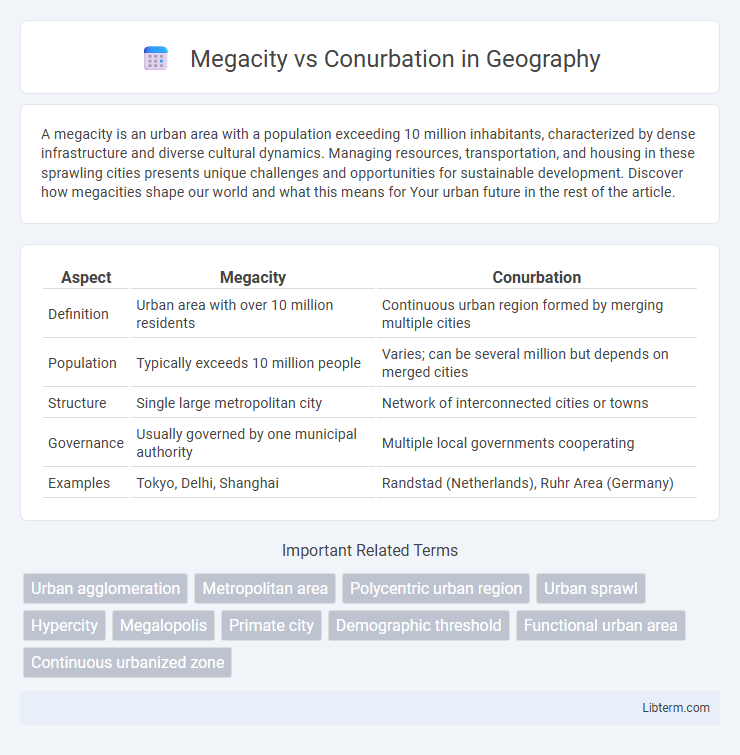A megacity is an urban area with a population exceeding 10 million inhabitants, characterized by dense infrastructure and diverse cultural dynamics. Managing resources, transportation, and housing in these sprawling cities presents unique challenges and opportunities for sustainable development. Discover how megacities shape our world and what this means for Your urban future in the rest of the article.
Table of Comparison
| Aspect | Megacity | Conurbation |
|---|---|---|
| Definition | Urban area with over 10 million residents | Continuous urban region formed by merging multiple cities |
| Population | Typically exceeds 10 million people | Varies; can be several million but depends on merged cities |
| Structure | Single large metropolitan city | Network of interconnected cities or towns |
| Governance | Usually governed by one municipal authority | Multiple local governments cooperating |
| Examples | Tokyo, Delhi, Shanghai | Randstad (Netherlands), Ruhr Area (Germany) |
Definition of Megacity
A megacity is defined as an urban area with a population exceeding 10 million inhabitants, often characterized by high population density and significant economic, cultural, and political influence. Unlike a conurbation, which is a continuous urban area formed by the merging of multiple cities or towns, a megacity typically refers to a single metropolitan area with a vast, centralized population. Examples of megacities include Tokyo, Delhi, and Shanghai, which showcase the complex infrastructure and diverse demographics typical of such large urban centers.
Definition of Conurbation
A conurbation is an extensive urban area formed when multiple cities, towns, and suburbs merge through population growth and physical expansion, creating a continuous metropolitan region. Unlike a megacity, which is a single city with over 10 million inhabitants, a conurbation consists of several interconnected urban centers functioning as a single economic and social entity. Examples of conurbations include the Greater Tokyo Area and the Ruhr region in Germany, where distinct municipalities collectively form a large, integrated urban zone.
Key Differences: Megacity vs Conurbation
A megacity is defined by a population exceeding 10 million people, while a conurbation consists of multiple cities or towns that have merged into a continuous urban area regardless of population size. Megacities often feature centralized economic, cultural, and political functions, whereas conurbations emphasize the spatial merging of distinct urban centers. The key difference lies in population scale for megacities and spatial urban agglomeration for conurbations.
Historical Development of Megacities
Megacities emerged primarily in the 20th century due to rapid industrialization and urbanization, with cities like Tokyo and New York leading this transformation. Their historical development is marked by significant population growth driven by rural-to-urban migration, advancements in transportation, and economic opportunities. Conurbations, in contrast, evolved through the merging of multiple adjacent cities and towns, but megacities are distinguished by their vast, densely populated urban core and global economic influence.
Historical Emergence of Conurbations
Conurbations emerged during the Industrial Revolution as rapid urban expansion caused multiple cities and towns to merge into extensive metropolitan areas. This historical growth was driven by industrialization, improved transportation networks, and population migration from rural to urban centers. Unlike megacities defined by population size, conurbations are characterized by their spatial integration of separate urban settlements into a continuous urban region.
Population Density and Urban Spread
Megacities typically exhibit extremely high population density concentrated within a single, continuous urban area, often exceeding 10 million inhabitants confined to a compact metropolitan region. Conurbations, by contrast, consist of multiple interconnected cities or towns that spread over a broader geographic area, resulting in lower average population density despite a similarly large total population. Urban spread in conurbations leads to more fragmented infrastructure and diverse urban planning challenges compared to the densified core structure seen in megacities.
Economic Significance in Urban Areas
Megacities, typically defined as urban areas with populations exceeding 10 million, serve as major global economic hubs driving innovation, finance, and international trade, often hosting headquarters of multinational corporations and advanced infrastructure. Conurbations, formed by the merging of multiple cities and towns, create extensive economic regions with diverse industries and labor markets that enhance regional productivity and inter-city connectivity. Both megacities and conurbations generate substantial economic activity, but megacities tend to have more concentrated economic power and influence on global markets, while conurbations support broader regional economic integration and development.
Infrastructure and Urban Planning Challenges
Megacities face complex infrastructure demands with high-density populations requiring extensive transportation networks, advanced water and waste management systems, and scalable energy supplies. Conurbations encounter challenges of integrating multiple urban centers, necessitating coordinated urban planning to address fragmented governance, inconsistent zoning laws, and varying infrastructure standards. Both require innovative solutions in smart city technology and sustainable development to manage congestion, environmental impact, and socio-economic disparities effectively.
Environmental Impact Comparison
Megacities often face severe environmental challenges such as air pollution, water scarcity, and extensive waste generation due to their high population density and industrial activities. Conurbations, formed by the merging of multiple urban areas, tend to experience fragmented environmental management, leading to inconsistent pollution control and habitat disruption across regions. Both urban forms contribute significantly to greenhouse gas emissions, but megacities typically exhibit more concentrated environmental stress, whereas conurbations may face broader ecological degradation over larger, interconnected areas.
Future Trends in Urban Growth
Megacities, defined by populations exceeding 10 million, are projected to expand rapidly due to rural-to-urban migration and economic centralization, especially in Asia and Africa. Conurbations, large urban regions formed by the merging of multiple cities, are expected to evolve through infrastructural integration and technological advancements, fostering seamless connectivity and regional economic collaboration. Future urban growth trends emphasize sustainable development, smart city technologies, and resilience to climate change, significantly shaping both megacity and conurbation expansion patterns.
Megacity Infographic

 libterm.com
libterm.com